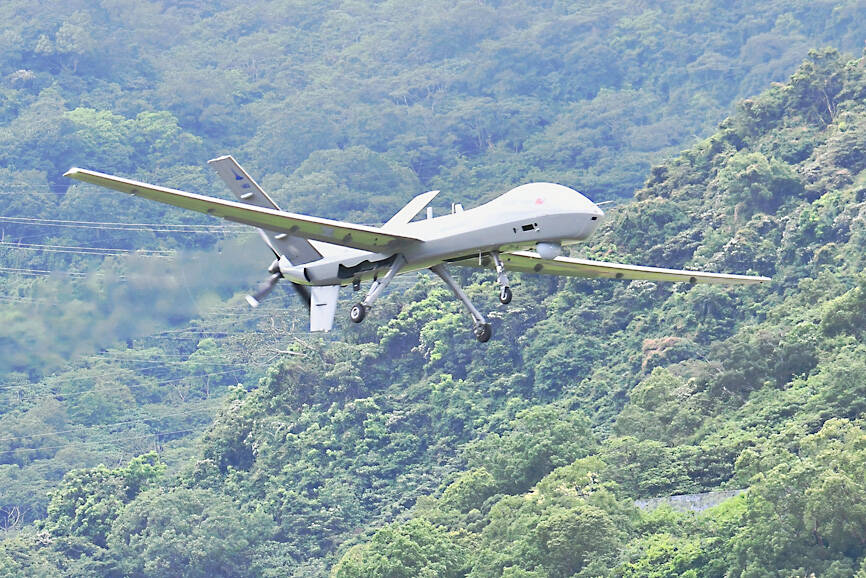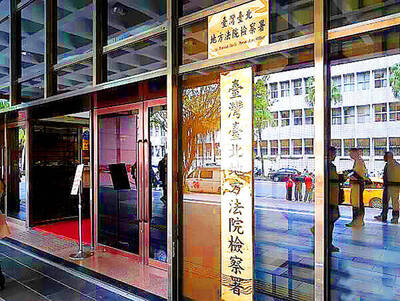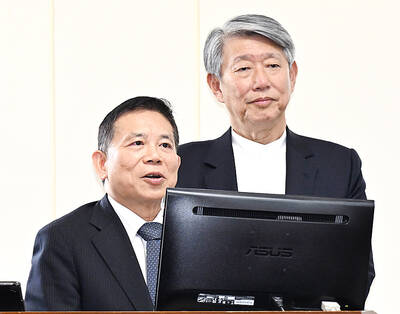Taiwan reached another defense milestone after the domestically developed Teng Yun 2 drone stayed airborne for more than 20 hours during its most recent test flight, a source said yesterday.
The drone broke its first record in June last year when it flew for 10 hours straight, following the entire perimeter of Taiwan’s air defense identification zone.
The new 20-hour record means that the drone could be used to monitor the Taiwan Strait for nearly an entire day at a time, the source said.

Photo: Yu Tai-lang, Taipei Times
Designed by the Chungshan Institute of Science and Technology, the Teng Yun 2, or “Cloud Rider 2” (騰雲二型), can operate day and night in all weather conditions, and is capable of aerial image surveillance and reconnaissance, electronic parameter reconnaissance, electronic interference, meteorological observation and relaying signals.
The Teng Yun 2 is a large, long-endurance, satellite-guided, medium-altitude drone that can carry multiple payloads, meaning that it can be used for surveillance or strike missions, information from the institute showed.
It can also take off and land autonomously, and has multiple guidance and control links, as well as ground-networked communication links.
“During a combat scenario, the drone could provide remote, real-time surveillance information, and could play an important early warning role,” the source said.
The Teng Yun 2 is expected to be used by the military alongside US-made MQ-9 Reaper drones, with the Reapers being responsible for high-altitude surveillance and reconnaissance missions, and the Teng Yun 2 to be used for medium and low-altitude missions, the source said.
The drone’s capabilities would give the military more flexible and robust surveillance capabilities, they said.
“However, the number of drones that the air force will purchase is still undetermined, and that would affect how they are deployed,” the source said.
The Chinese military is also developing drones, which it hopes will strengthen its surveillance and reconnaissance capabilities, so Taiwan’s military must simultaneously surveil at different altitudes to give it an advantage, the source said.
In other military news, the Ministry of National Defense said that over the past 24 hours it had detected eight Chinese fighter jets crossing the median line of the Taiwan Strait, as well as one Chinese balloon.
The ministry said the Chinese J-10, J-11 and J-16 fighter jets had crossed the median line to the north and center of the Strait.
The median line once served as an unofficial barrier between the two sides, but Chinese planes now regularly fly over it.
Taiwan sent its own forces to monitor the fighter jets, the ministry said.
The ministry also reported another Chinese balloon in the Strait.
Taipei officials have said the balloons are most likely for monitoring the weather, and the spate of sightings could be due to the direction of winds.
The balloon was spotted after crossing the median line late on Saturday morning, 97 nautical miles (180km) northwest of Keelung at an altitude of approximately 6,100m, the ministry said, adding that it headed east and disappeared about an hour later.
The potential for China to use balloons for spying became a global issue in February when the US shot down what it said was a Chinese surveillance balloon. China said the balloon was a civilian craft that had accidentally drifted into the US.
Additional reporting by Reuters

Intelligence agents have recorded 510,000 instances of “controversial information” being spread online by the Chinese Communist Party (CCP) so far this year, the National Security Bureau (NSB) said in a report yesterday, as it warned of artificial intelligence (AI) being employed to generate destabilizing misinformation. The bureau submitted a written report to the Legislative Yuan in preparation for National Security Bureau Director-General Tsai Ming-yen’s (蔡明彥) appearance before the Foreign Affairs and National Defense Committee today. The CCP has been using cognitive warfare to divide Taiwanese society by commenting on controversial issues such as Taiwan Semiconductor Manufacturing Co’s (TSMC, 台積電) investments in the

INVESTIGATION: The case is the latest instance of a DPP figure being implicated in an espionage network accused of allegedly leaking information to Chinese intelligence Democratic Progressive Party (DPP) member Ho Jen-chieh (何仁傑) was detained and held incommunicado yesterday on suspicion of spying for China during his tenure as assistant to then-minister of foreign affairs Joseph Wu (吳釗燮). The Taipei District Prosecutors’ Office said Ho was implicated during its investigation into alleged spying activities by former Presidential Office consultant Wu Shang-yu (吳尚雨). Prosecutors said there is reason to believe Ho breached the National Security Act (國家安全法) by leaking classified Ministry of Foreign Affairs information to Chinese intelligence. Following interrogation, prosecutors petitioned the Taipei District Court to detain Ho, citing concerns over potential collusion or tampering of evidence. The

‘COMPREHENSIVE PLAN’: Lin Chia-lung said that the government was ready to talk about a variety of issues, including investment in and purchases from the US The National Stabilization Fund (NSF) yesterday announced that it would step in to staunch stock market losses for the ninth time in the nation’s history. An NSF board meeting, originally scheduled for Monday next week, was moved to yesterday after stocks plummeted in the wake of US President Donald Trump’s announcement of 32 percent tariffs on Taiwan on Wednesday last week. Board members voted to support the stock market with the NT$500 billion (US$15.15 billion) fund, with injections of funds to begin as soon as today. The NSF in 2000 injected NT$120 billion to stabilize stocks, the most ever. The lowest amount it

NEGOTIATIONS: Taiwan has good relations with Washington and the outlook for the negotiations looks promising, Minister of Economic Affairs J.W. Kuo said Taiwan’s GDP growth this year is expected to decrease by 0.43 to 1.61 percentage points due to the effects of US tariffs, National Development Council (NDC) Minister Paul Liu (劉鏡清) said at a meeting of the legislature’s Economics Committee in Taipei yesterday, citing a preliminary estimate by a private research institution. Taiwan’s economy would be significantly affected by the 32 percent “reciprocal” tariffs slapped by the US, which took effect yesterday, Liu said, adding that GDP growth could fall below 3 percent and potentially even dip below 2 percent to 1.53 percent this year. The council has commissioned another institution